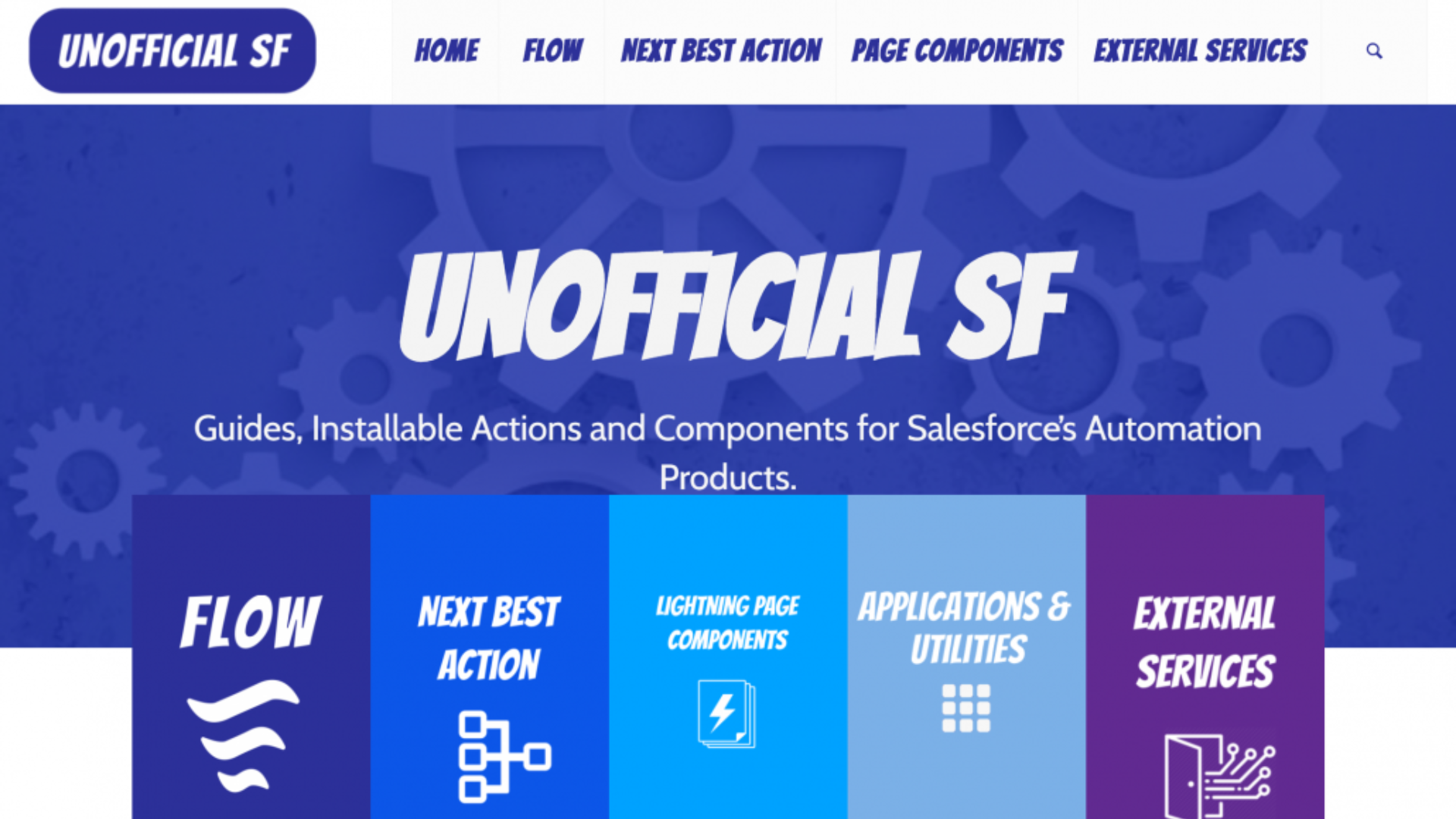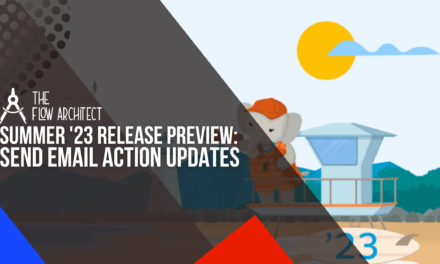The Spring ’24 Salesforce release is officially here… The last release weekend took place on Saturday, 10 February, and with this release came a number of really great updates! In this post, we’re going to provide a bit of a recap of this release’s edition of Flow Release Readiness Live. This will not be an extensive recap but will highlight the key things that were covered. If you want to get a more in-depth understanding of what was covered, I would encourage you to go back and watch the full episode on Salesforce+.
For this edition of Release Readiness Live, the recording was broken down into these three main sections:
- Flow-Pourri (aka General Flow Updates)
- Screen Flow Updates
- Integration and Data Transformation Enhancements
For the purposes of this post, we will break the headings down into these three key sections and highlight the biggest takeaway in each. We’ll also share some screenshots of items covered in these sections for your reference. With that in mind, let’s dive right in.
Flow-Pourri (aka General Flow Updates)
This section covered a lot of areas in a relatively short amount of time. We’ll try to cover the biggest talking points here, but once again, for a more detailed overview, I’d encourage you to read through the relevant release notes or watch the RRL episode.
Updated Workflow Rule and Process Builder Retirement Roadmap
This edition of Release Readiness Live included an updated retirement roadmap for Workflow Rules and Process Builder. It’s been a gradual process over the last two and a half years working towards the retirement of these older automation tools, and in this episode of RRL, Diana Jaffe provided an important and significant update that all Salesforce Admins should be aware of.
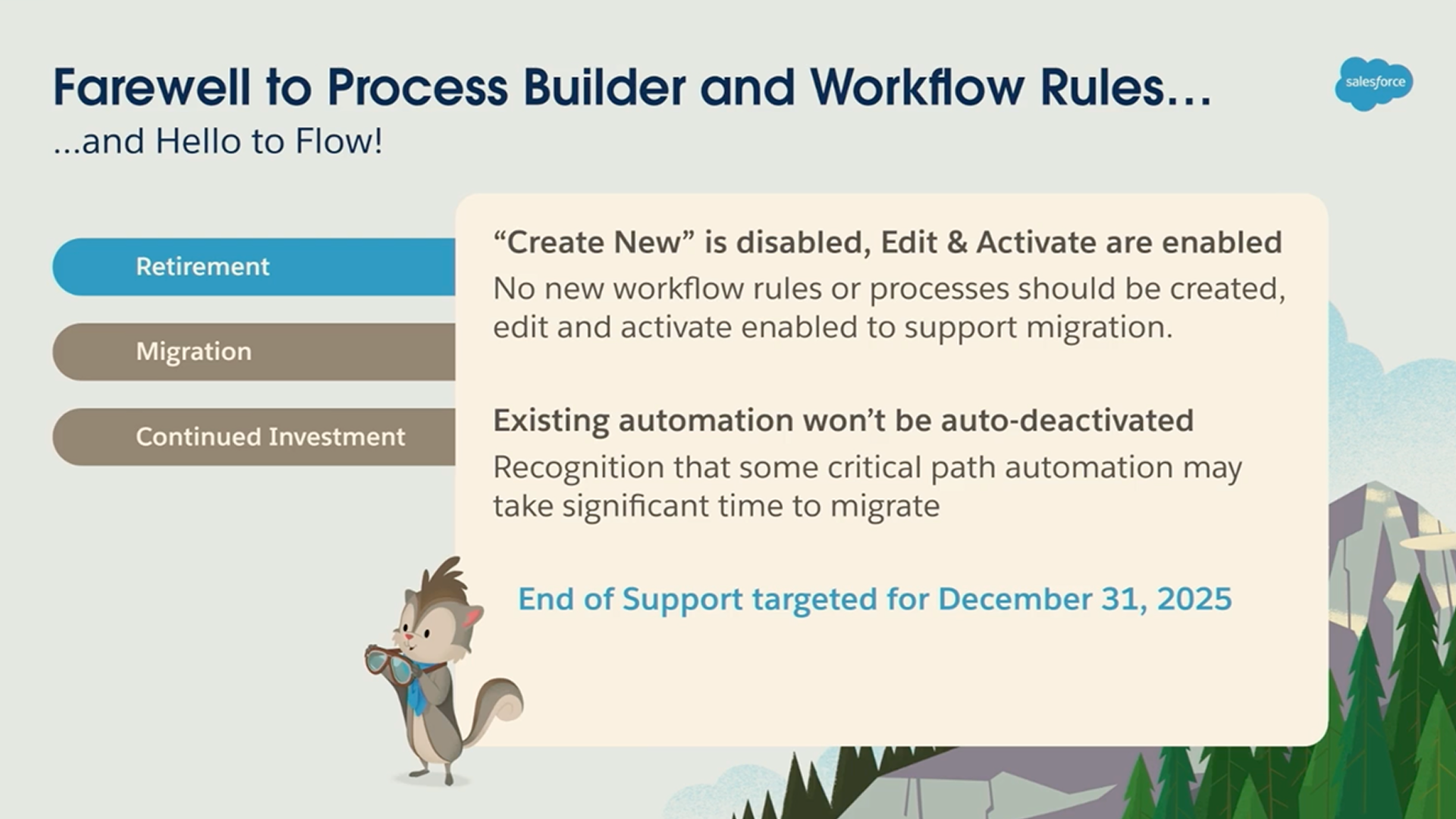
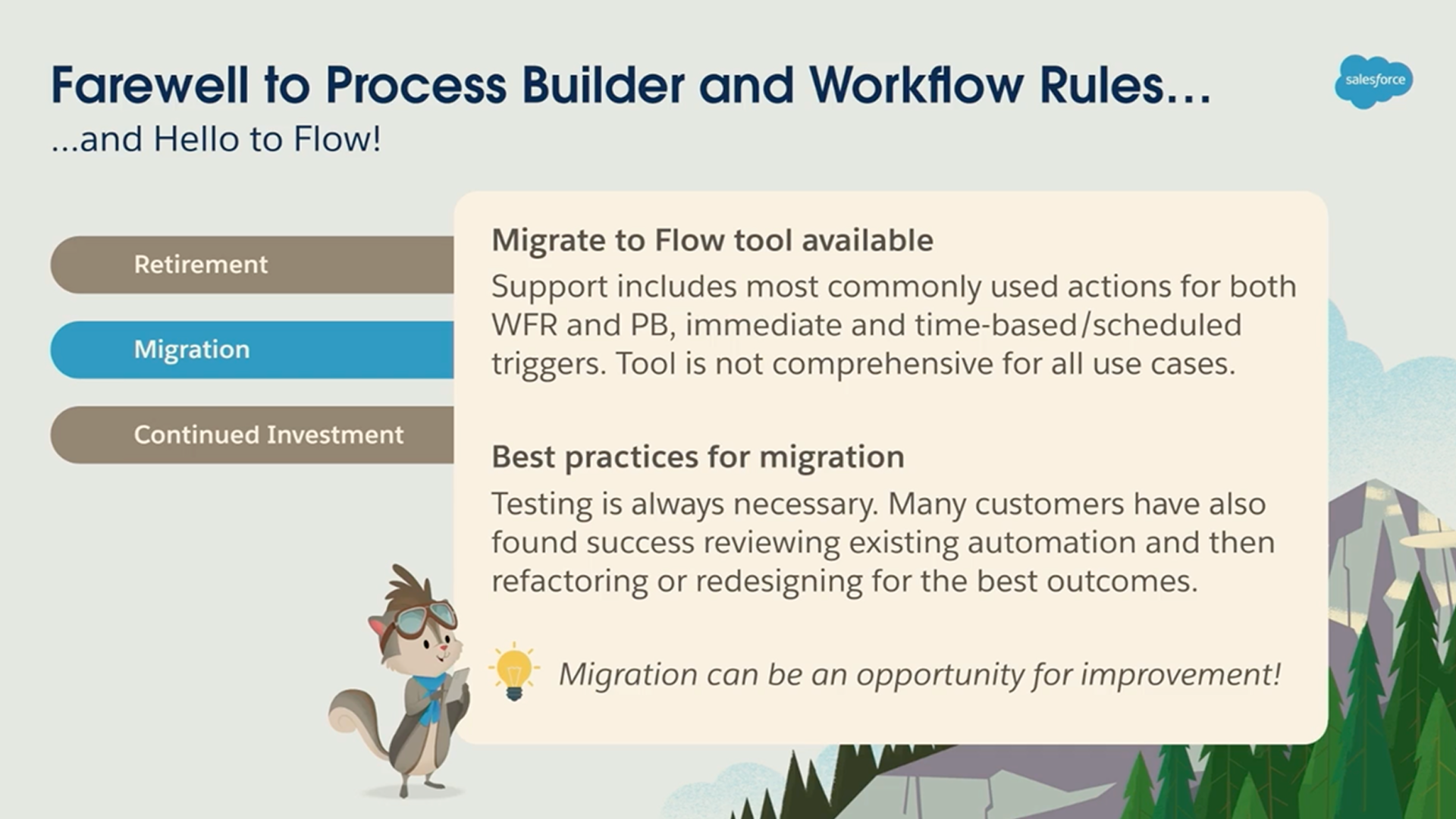
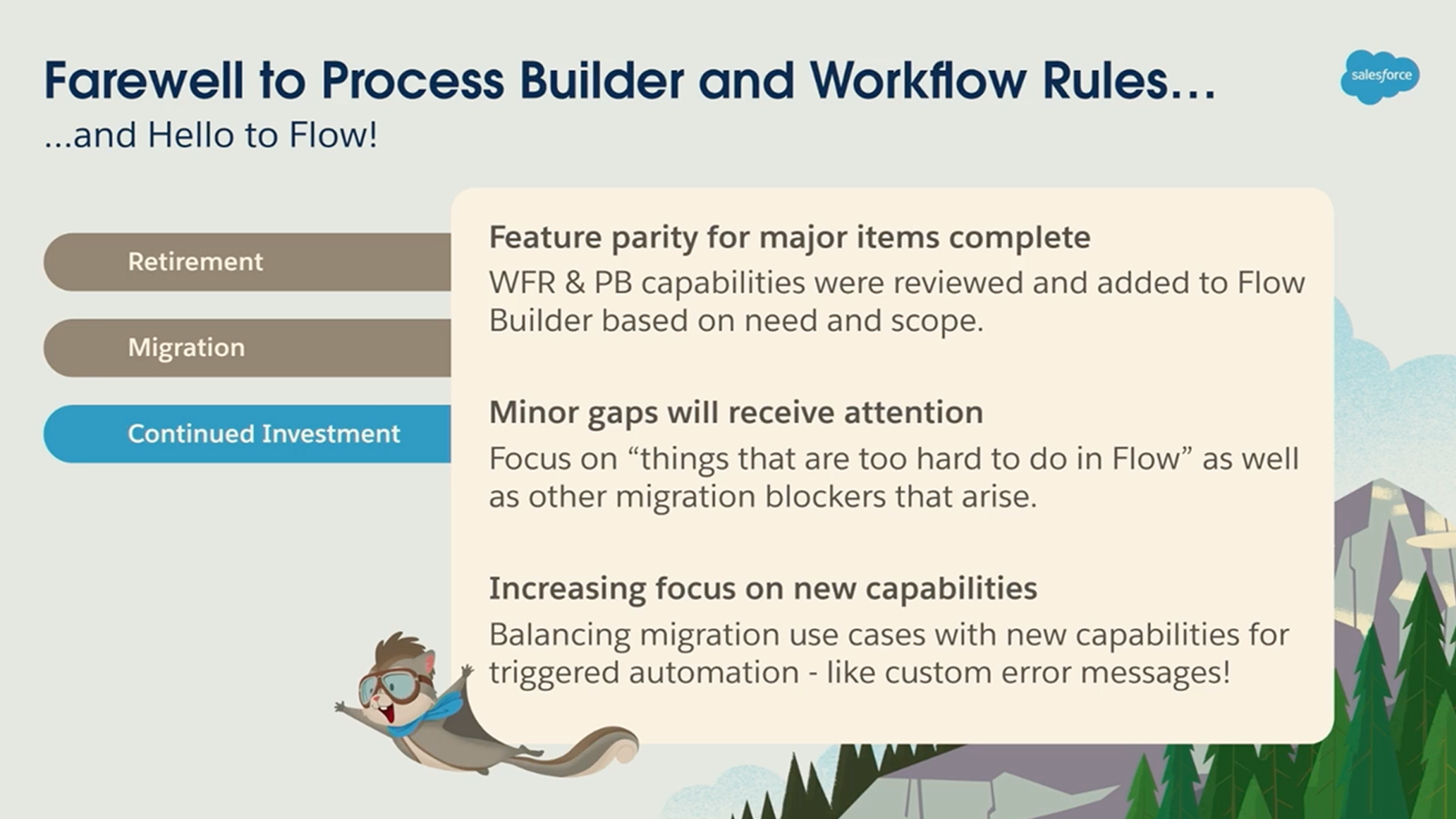
The update from Diana broke this down into three core subjects: Retirement, Migration, and Continued Investment. However, the biggest thing that you should know about is the target date for the end of support for Workflow Rules and Process Builder. The date that Diana shared on screen, which is shown in the screenshots above, is currently set as 31 December 2025. This gives Admins just under two years to work on getting ALL of their declarative automations in Salesforce into Flow.
I may write a more extensive blog about this in the future, but what you really need to know is that this will most likely not be a hard switch off of existing Workflow Rules and Process Builders. At the time of writing, there is no indication of this happening. What end of support will mean is that you will not be able to get support from Salesforce’s Support Team if something goes wrong with an existing Workflow Rule or Process Builder. It will be somewhat akin to using historical versions of Windows OS in the sense that you will still be able to use them if you have them, but if something goes wrong, you’ll be stuck. Because of this, it makes sense for Admins to work on getting their older automations in things like Workflow Rules and Process Builder into Flows.
Updates to the Flow Canvas
The second biggest talking point from this section was around the changes being made to the Flow canvas across ALL Flows.
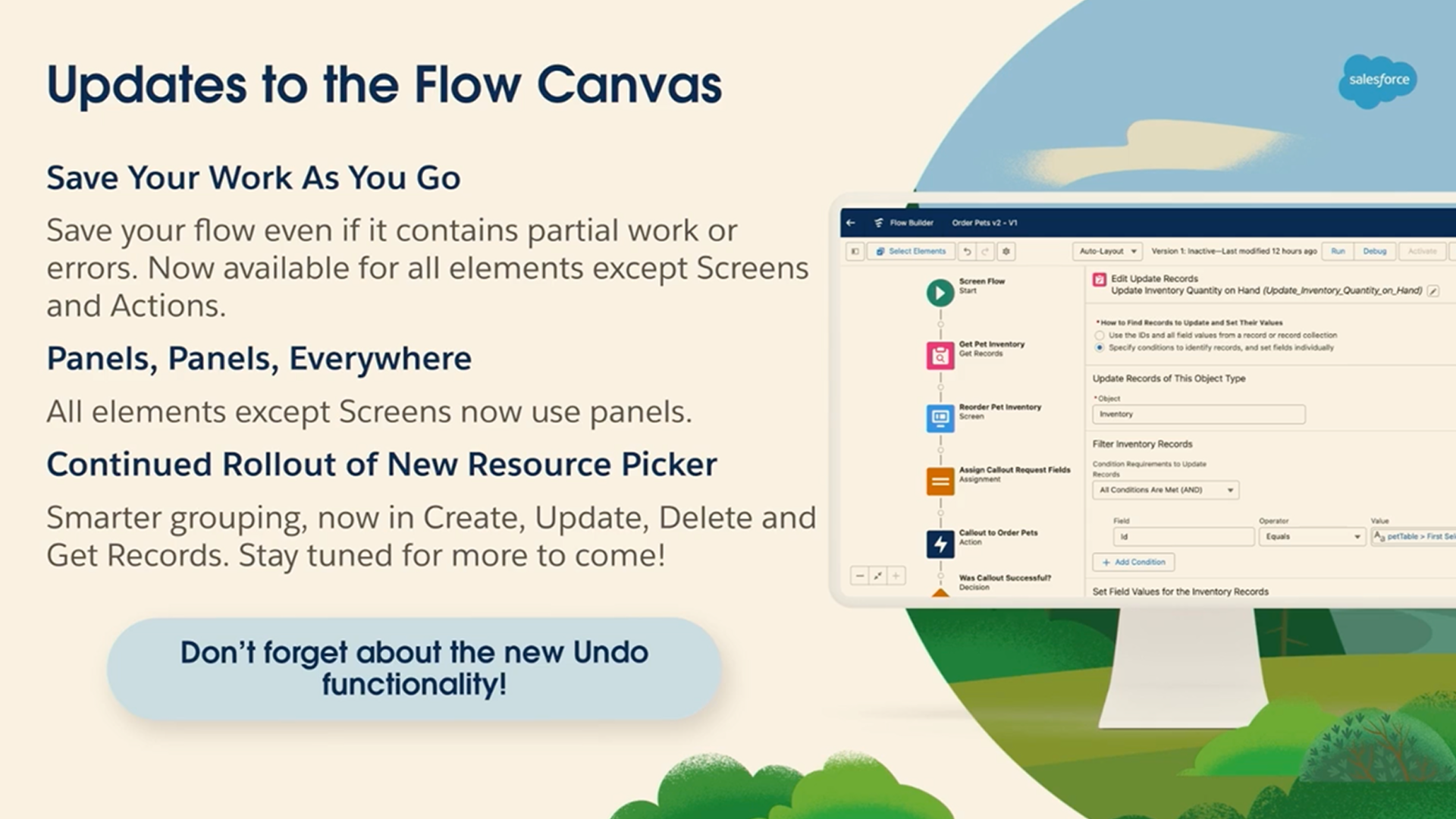
This release sees more movement towards the ability to save Flows in Draft Mode. Now, in the Spring ’24 release, you can save Flows even if elements are not fully completed (this works for all elements except Screens and Actions).
Alongside this, Salesforce is really pushing the usage of the panel that was first introduced in Flow Orchestrator (that’s where it was first implemented if you hadn’t seen it before). The panel has a small X at the top right which will allow you to leave the panel you are building.
The more up-to-date panel is something I’m planning to cover a little more in-depth in a future post, however, the key thing that I think you need to understand right now is a couple of the major issues that I have observed with this new approach. To be transparent here, I don’t dislike the panel approach, in fact, I think that it could be better when (and if) Salesforce finally gets it right. Right now, I don’t think the framework for the panel is correct. This is largely because the close module is obscured if you use the Salesforce Inspector or Salesforce Inspector Reloaded browser add-ons; if you use these add-ons, they really do get in the way of the panels. Alongside the Inspector issue, there is how the canvas and panels work on bespoke monitors such as vertical monitors. Right now, if you use a vertical monitor to design your Flows (as I do), the panels will appear on the right-hand side of your screen, and they don’t effectively resize. This means to get the best viewing ratio you have to zoom out by 20% or more depending on your screen. These two issues don’t deter me from saying that panels are a good step forward, but the UX side of things does need to be worked on. I would be interested in hearing your experiences with the new(ish) panel experience.
Other Key General Updates to Flow Builder
To wrap up this section, Diana also highlighted a couple of additional items that you will benefit from knowing about.
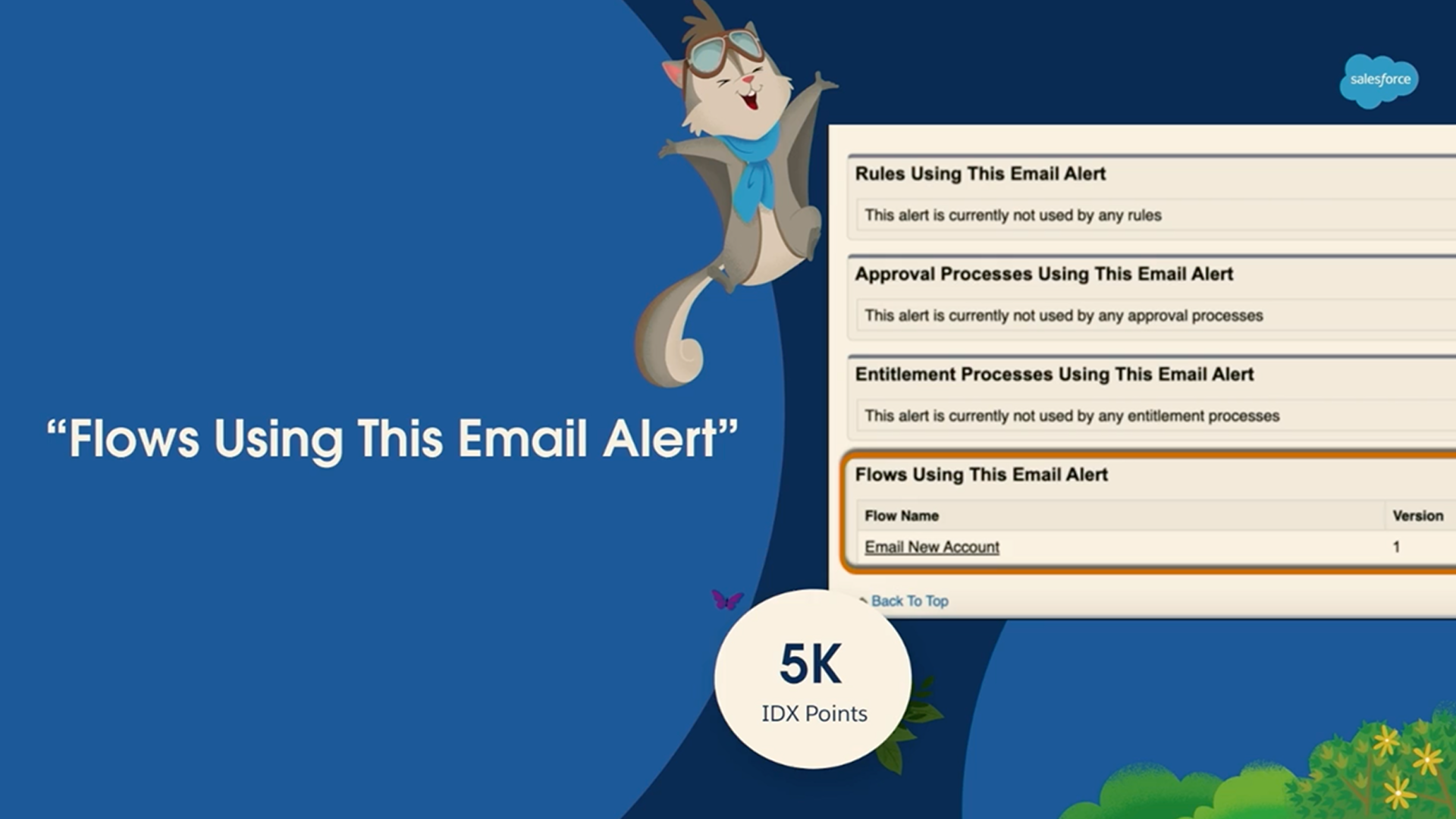
Flows Using This Email Alert
In the Spring ’24 release, we finally have a table included for Email Alerts which lists the Flows that are using said Email Alert.
This table will be displayed in your Email Alert which you can access via setup. The table will display two columns for now including the Flow Name (which is hyperlinked to the Flow itself) and the Version Number/s that are using the Email Alert in question. It’s a nice update.
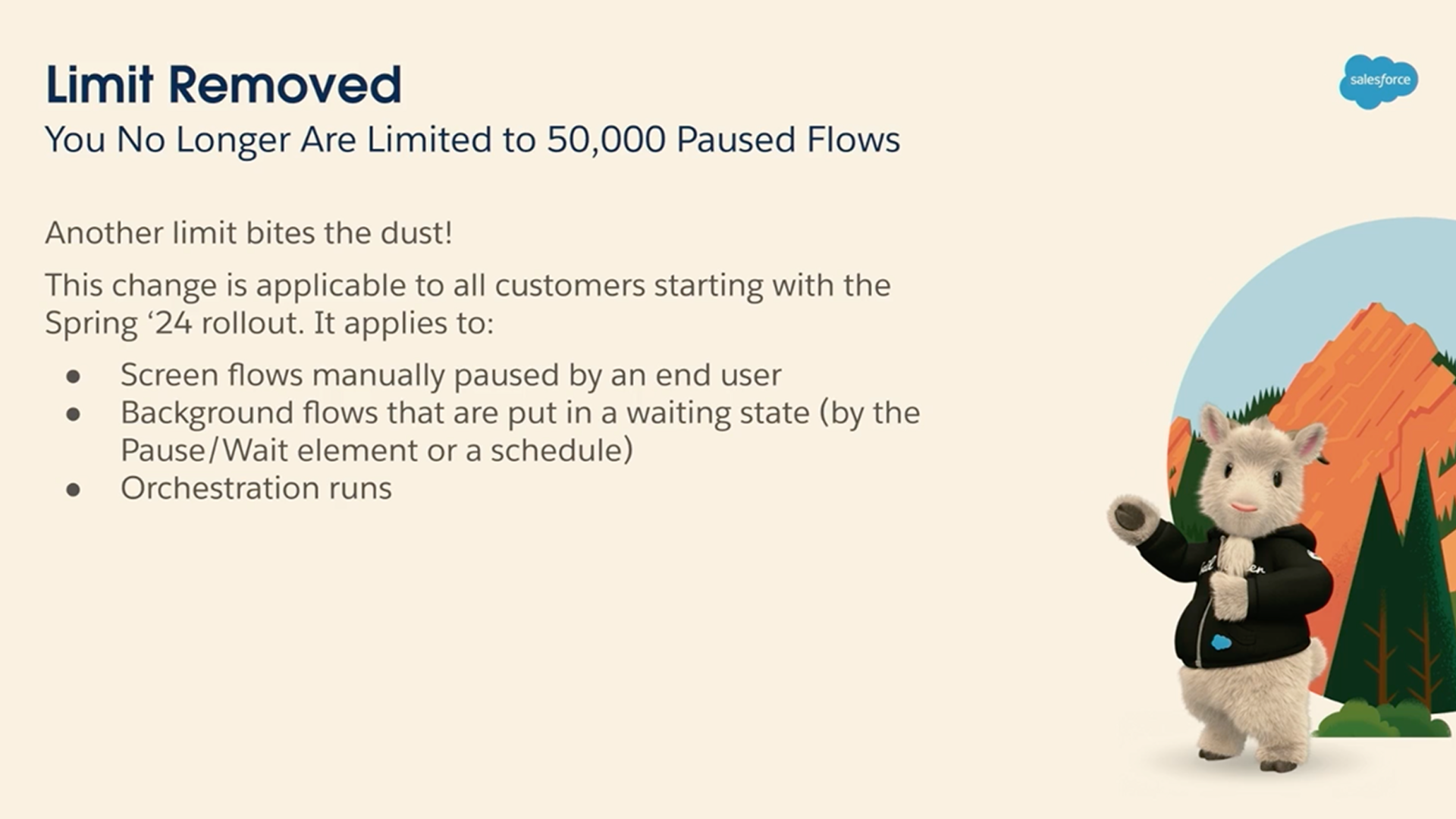
Paused Flows Limit Removed
Finally, for this section, the historic Paused Flows Limit of 50,000 has now been removed. This change applies to Screen Flows manually paused by a user, Flows put into a waiting state due to a Wait Element, and Orchestration runs. This update carries on the trend started last year in the Spring ’23 release of the removal of certain limits. Last year it was the Flow Element Iteration limit that was removed. Could this be a trend of annual limit removals in the Spring?
Screen Flow Updates
Let’s now move onto the section around the updates to Screen Flows. This section for me is one of the biggest highlights in this release. Since the Spring ’23 release last year around the time of TDX ’23, Screen Flow has been on a real roll of great updates with the addition of Reactive Screen Flows and subsequent updates around that year in the releases that would come to follow.
The New Repeater Component
The first of the big updates for Screen Flow that I want to cover is the new Repeater Component that has been added in this release. I won’t talk too much about the component as I’ve previously written a post about it. What I will say about it here is that I think this new component is one of the singular best updates to come to the Flow since I started building Flows in 2020.
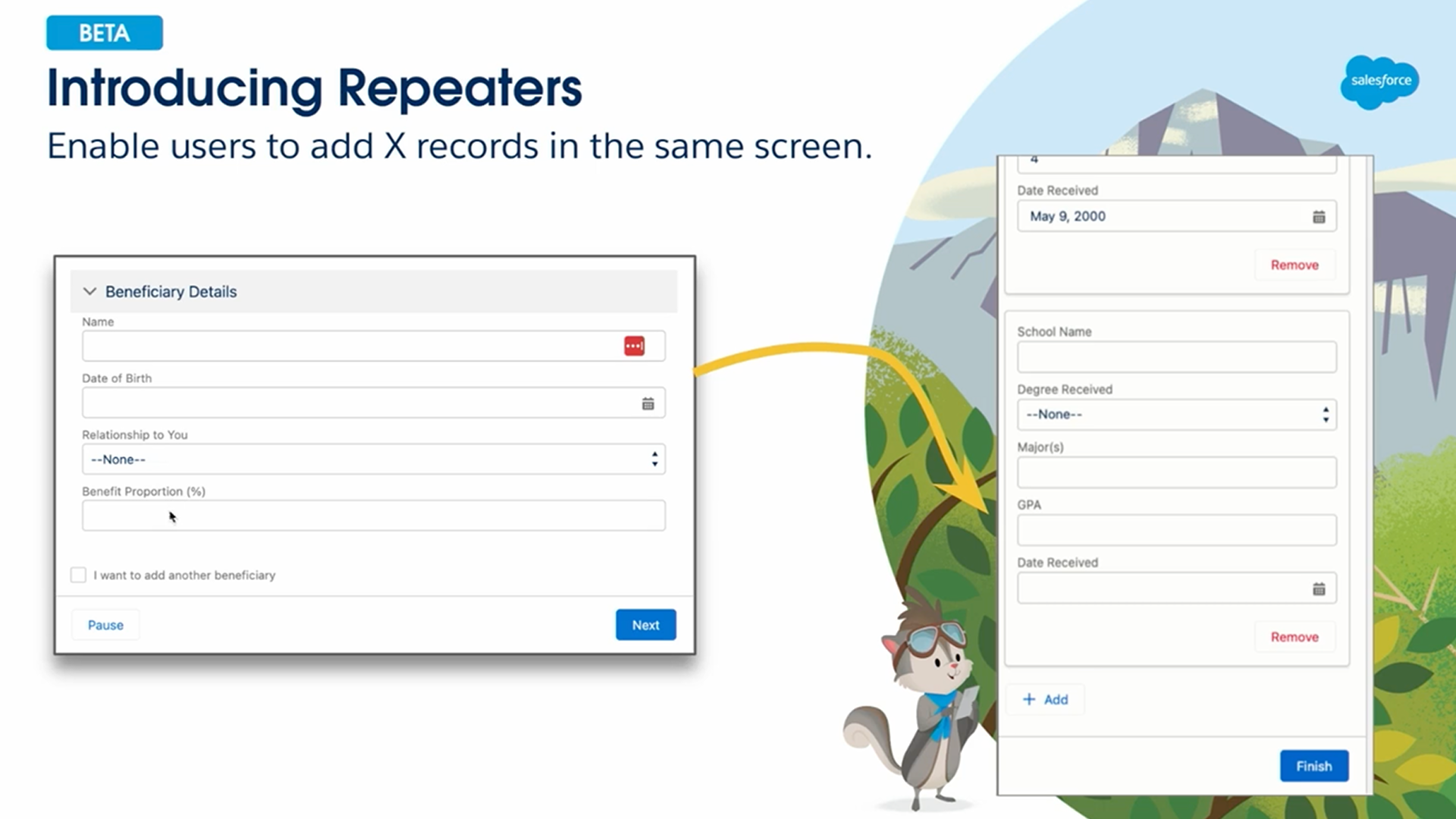
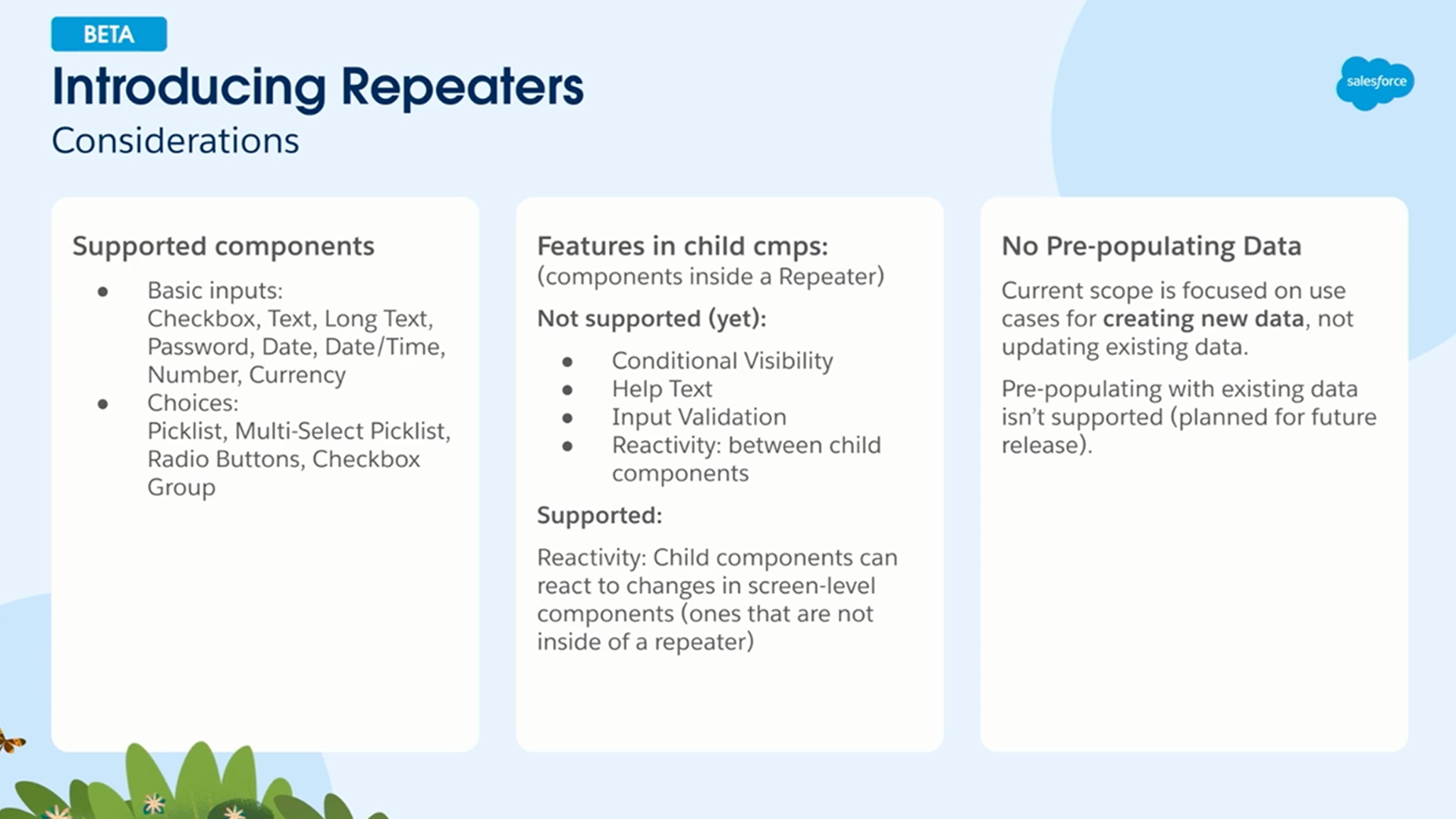
The Repeater Component allows Admins to use standard Screen Flow Input Components in (pardon the pun) repeatable sections. There are some exceptions on which components can be used in a repeated section (check out the screenshot above for that list). The Repeater Component creates a bespoke version of a collection which needs to be looped around in order to do bulk tasks such as Create, Update, or Delete Records; in my experimentation with it, it’s very user-friendly and will be very valuable.
More Updates to Reactive Screen Flows
This release also sees more updates for Reactive Screen Flows, continuing the significant momentum that has been building for this set of functionality. While there are some things that are still to come, this release sees some really good additions added.
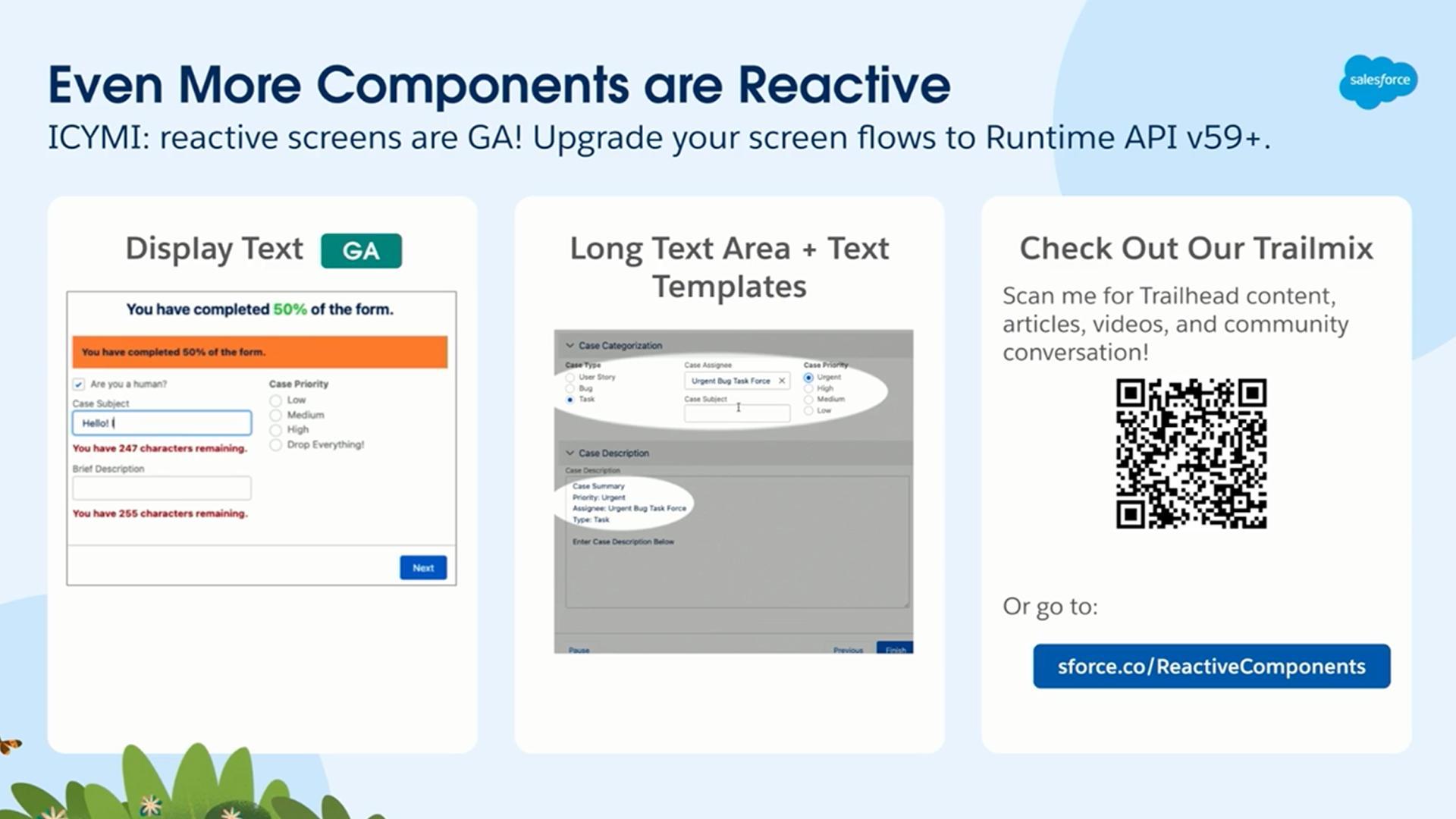
In this release, the main things that were updated for Reactive Screen Flows is that the option for Reactive Display Text that was released in Beta form in the Winter ’24 release is now officially GA. There is also now reactivity enabled for Long Text Area input components and Text Templates in Screen Flows. I have not tested the latter update out for myself, but if they work as was shown in the demo, then this update will be something that Admins will very quickly fall in love with and want to use a lot.
More Input Validation for Screen Flows
The final key update highlighted in this release was updates to Screen Flows input validations (aka Flow Validation Rules).
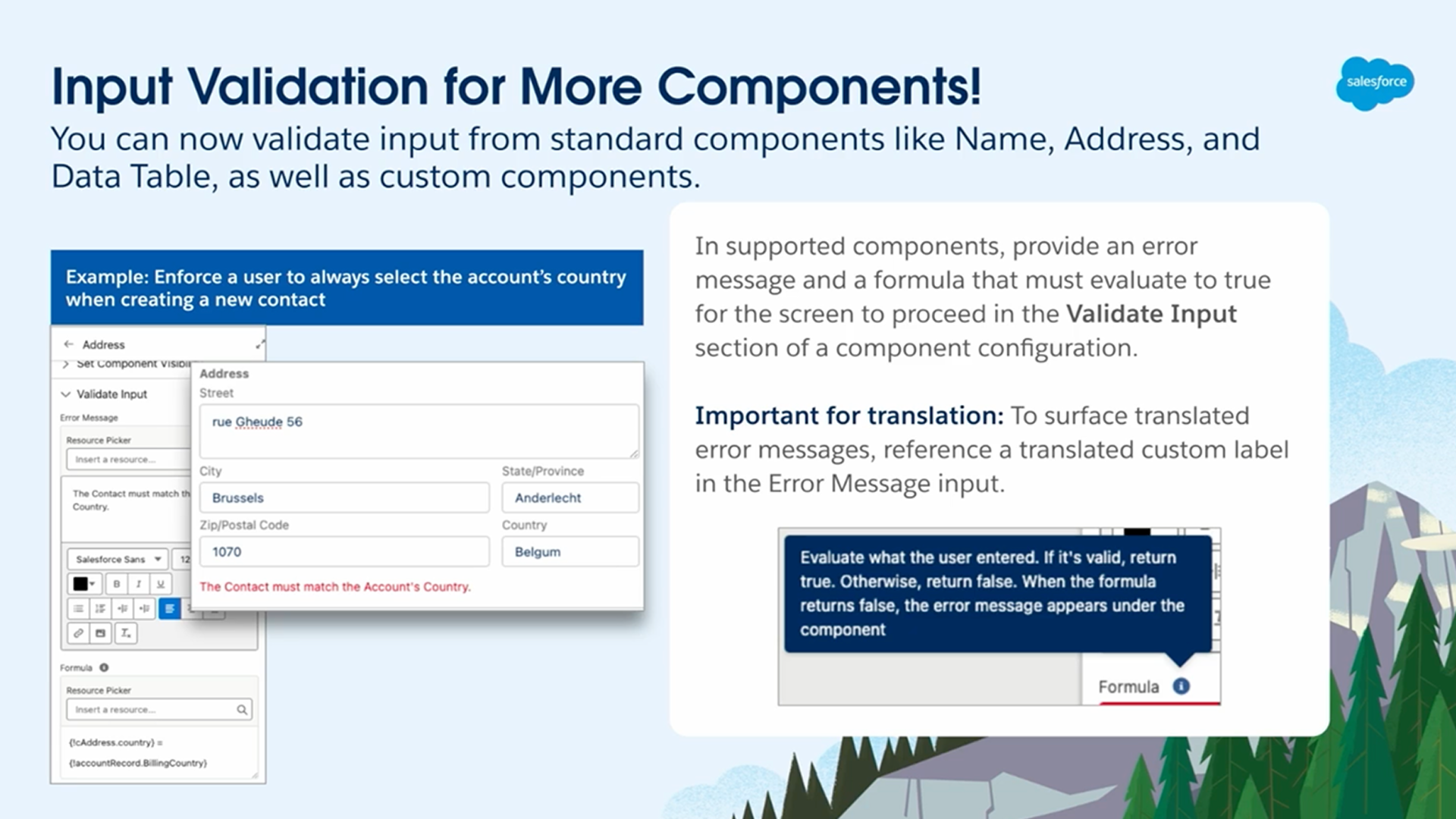
This release sees the addition of Input Validation for standard components like Name, Address, and Data Table along with ALL custom components. This is a significant stride as it allows users to add that validation. Alongside this, there is also now an information icon that displays help text to explain how input validation works. This is very helpful for Admins as it will prevent confusion as Input Validation for Screen Flows work in the opposite way to that of standard Validation Rules in Salesforce.
Integration and Data Transformation Enhancements
We now move into our final section to cover in this post. That being the section around the Integration and Data Transformation Enhancements. This section particularly focused on the Transform Element and HTTP Callouts which were both introduced in 2023.
Transform Element Updates
This release sees some really crucial updates coming to the Transform Element. In full transparency, this is not an element I’ve really used just yet, as a result, I can’t comment on it from experience and can only share what was covered in the RRL episode.
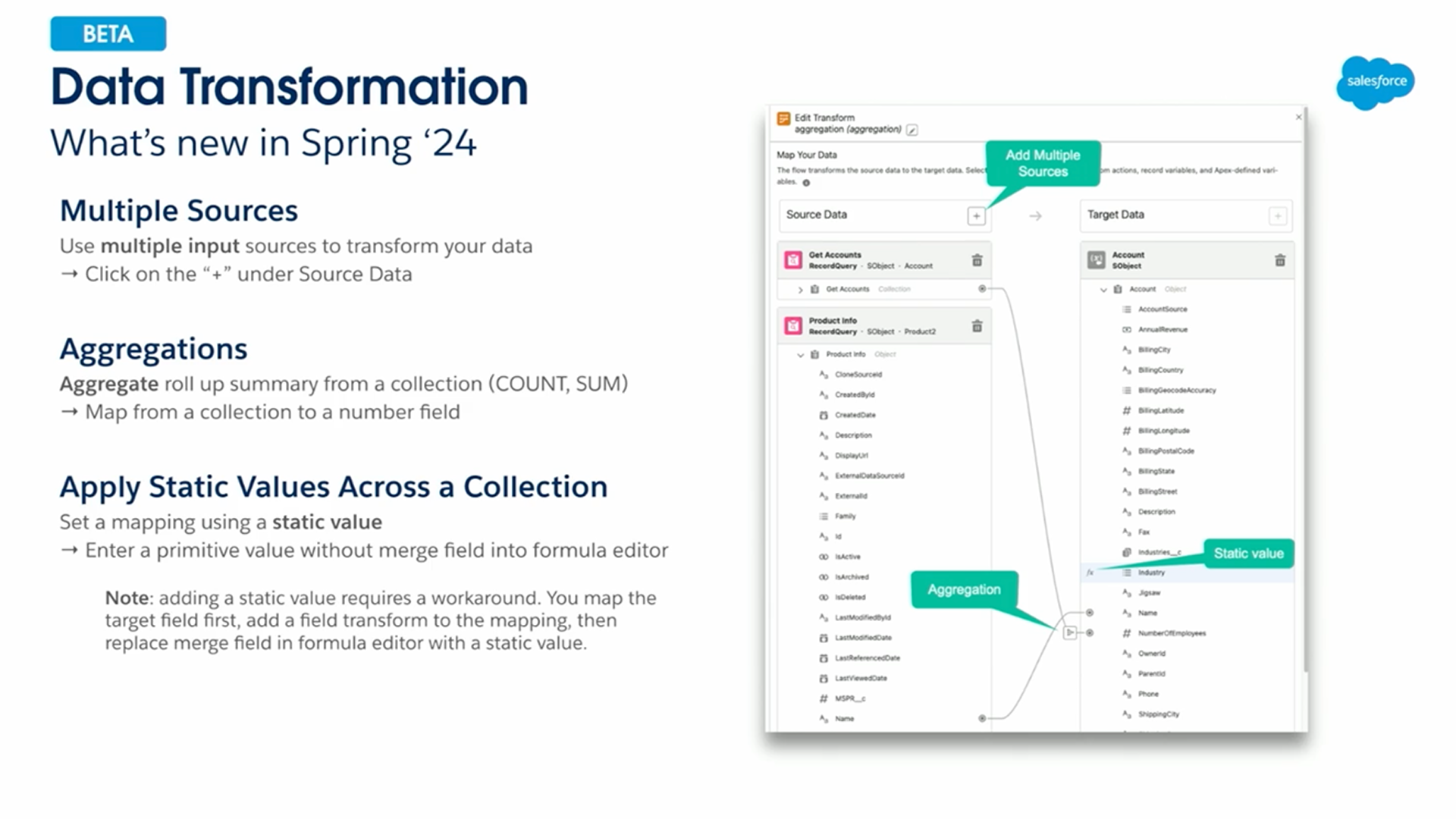
In Spring ’24, the Transform Element sees the addition of the ability to include multiple sources for your source data options. Along with this are enhancements to the Aggregate functionality and the ability to apply static values to a collection that is built via the element. These additions sound really cool to me and make it much more appealing for a more conscious effort to try out this element. Have you tried it yet, if so what did you think?
Updates to HTTP Callouts
Last but not least are the updates that were highlighted for the HTTP Callout action that was launched in the Spring ’24 release.
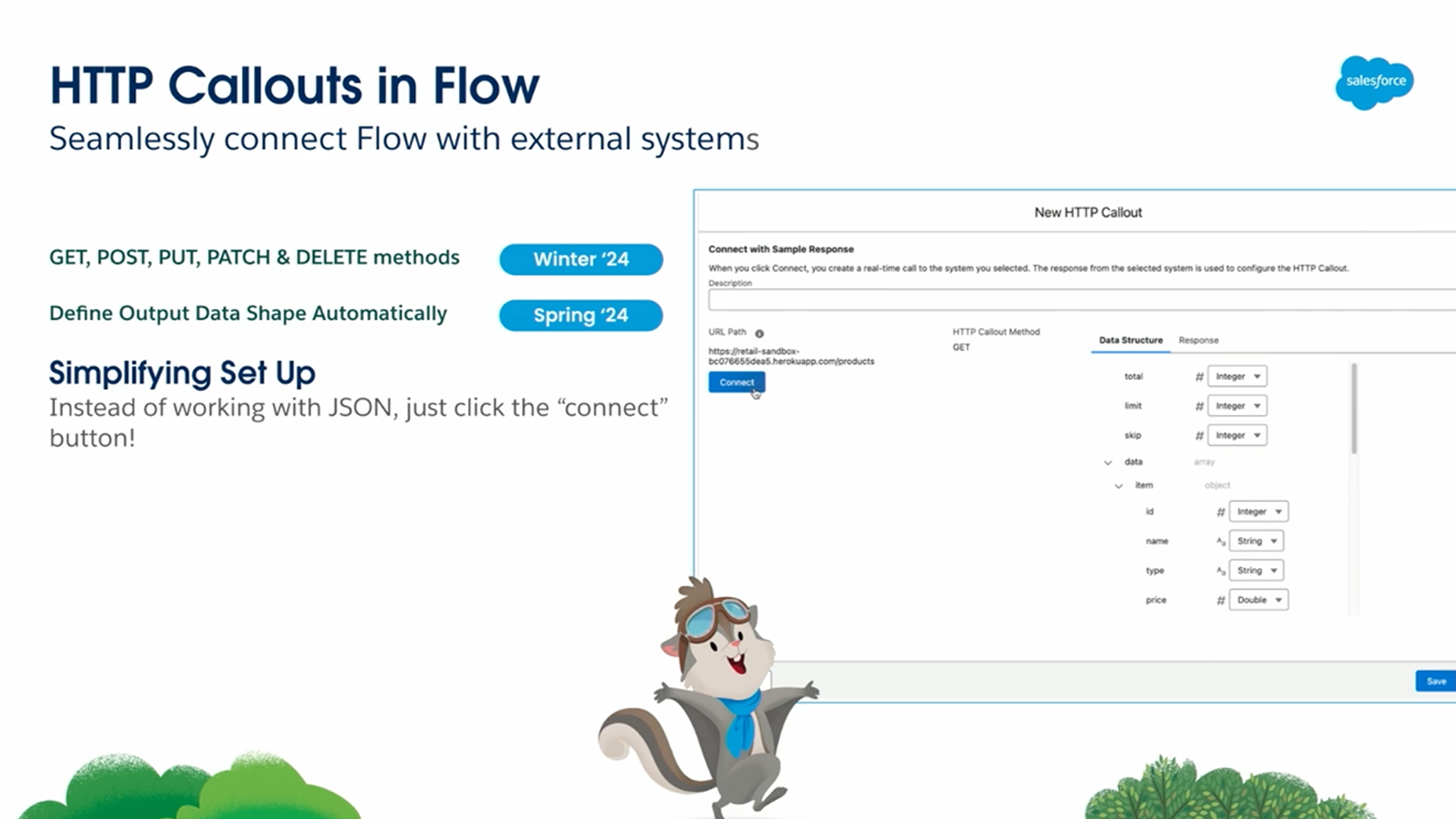
The biggest update to HTTP Callouts in this release is the ability to connect straight to your External Service and return the Output Data Shape without the need to add sample JSON. This is achieved by clicking on a Connect button, from there a callout will go out to the External Service requesting the Data Shape fields before creating the Output Data Shape.
This is a significant update as it will allow Admins to create powerful HTTP Callouts without the need to learn or understand JSON.
Closing Remarks
So that’s my recap of the Spring ’24 Flow Release Readiness Live. There are a number of other updates that have come as part of this seasonal release, all of which can be found in the Spring ’24 Release Notes. The other main area highlighted is the updates to the relatively new Data Cloud Triggered Flows which were launched in Winter ’24, I haven’t covered that due to lack of knowledge on my part as I do not work with any clients who use Data Cloud, and as a result, I haven’t had the chance to use these Flows yet.
But what about you? Have you had the chance to check out some of the updates to Flow that are a part of the Spring ’24 Release? If so, what has stood out to you? Let me know your highlights in the comments section. I’d love to hear what you think have been the biggest and best updates that have formed part of this most recent release. So share your thoughts in the comments section.
I’m in the middle of planning out content for this year for this blog, so please do let me know if there are any topics you particularly want to see covered. I’m probably going to write a post on the panel updates in a UX design post along with some content on the end of support for Workflow Rules and Process Builder in 2025. But let me know if there’s anything you’d like to see me cover.
Resources
We have three resources to link to this awesome post … these resources focus specifically on the Spring ’24 Release. The first is a post from UnofficialSF providing us with a major sneak peak on some of the updates coming to Flow in this release. The next is a post from Salesforce Ben highlighting some of the best Flow updates in this release. The final is a post from SalesforceTime.
Sneak Preview: Salesforce Flow Features Coming in Spring ’24
In this post from UnofficialSF, the team provides us with a high-level overview of some of the highlights in the recent Spring ’24 seasonal release regarding updates to Salesforce Flow.
Salesforce Spring ’24 Features: Top 10 Flow Updates You Need to Know
SalesforceBen provides us with per-release post that highlights the biggest and best updates to Flow Builder that are a part of this most recent. Read the post now to see their highlights.
New Flow Features of Spring ’24 Release
This post from SalesforceTime focuses on some of the standard updates to Flow Builder that have come out as part of the seasonal Spring ’24 release. This post is very much worth a read.


